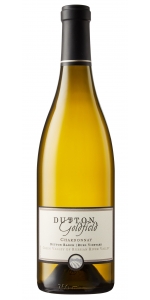Wine from Dutton-Goldfield
Dutton-Goldfield Winery began with a handshake in a vineyard in 1998, when longtime colleagues and friends Steve Dutton and Dan Goldfield recognized a shared vision between them—to craft wines that express the personalities of their cool-climate vineyards, and which they'd enjoy drinking at their own dinner tables.
A fifth-generation farmer, Steve grew up with a love of driving tractors, and without any doubt about his future career. His father, Warren Dutton, had begun growing grapes in the western reaches of Russian River Valley in the mid-1960s, at a time when most people thought the area was too cool to grow fruit for quality still wine. Steve started working with his father when he was five years old, and joined Dutton Ranch full-time in 1987. Today, along with his mother and brother, he manages the family business, which has grown from its original 35-acre home shop vineyard to over 80 separate vineyards comprising more than 1,000 acres throughout western Russian River Valley.
After graduating from Boston's Brandeis University, Dan headed west to begin a career in research chemistry, with a few detours for skiing and hiking on the way. Always an outdoor enthusiast, the life of lab work was quickly replaced with a dream of winemaking when his brother turned him on to the 1969 Burgundies. Dan entered the University of California at Davis, graduating with an M.S. in Enology in 1986. He gained knowledge on the job with stints at Robert Mondavi Winery and Schramsberg as well as winemaking in Portugal for two years. He found his passion in Pinot Noir and Chardonnay, first as the winemaker at the Burgundian-focused La Crema Winery, and then at Hartford Court, which was created under his direction. Dan's appreciation for the beauty of the extraordinary landscape around our home is reflected in his winemaking.
Dutton-Goldfield Rued Vineyard Chardonnay is made from 100 percent Chardonnay.
The nose leads with tangerine, apricot, and kiwi fruit, accented by lemon oil, orange blossom, and hazelnut. In the mouth, the fruit/floral and bright/rich theme continues, with the lychee and Meyer lemon top notes joined by Asian pear and Gravenstein apple, framed with honeysuckle and gardenia.
The dual nature of the wine makes it pair well with both rich and light fare, like lobster roll, roasted pork, or sautéed sole.
Review:
From a clone once called the Chardonnay Musque selection, this wine is highly aromatic and fresh. Juicy tropical fruit and tangerine flavors remain crisp and brilliant, leading to a complex midpalate of Meyer lemon and pear. The finish is topped by lasting, lingering layers of hazelnut.
- Wine Enthusiast 94 Points
- back
Selected Options
Wineries
Categories
Pricing
Countries
Regions
Grape Types
Wineries
Organic/Free Shipping
Florence Cholet Meursault Blanc is made from 100 percent Chardonnay.
This classic Meursault offers expressive and complex aromas of white flower, white fruit, and herbal aromas. Bright acidity and minerality emerge on the palate from this beautifully balanced and structured white, followed by subtle hints of vanilla and toasted brioche nuances in a refreshing finish.
Pair with fresh Truffle Pasta, Beaufort Cheese, Pike Quennelles.
Gaja Sperss is made from 100 percent Nebbiolo.
Vibrant and intense notes of herbs and spices such as thyme, cloves and black pepper. On the palate the wine is tense, loaded with energy that will need serious ageing to fully develop although extremely approachable in its youth. Impressive fruit concentration, with dark and ripe fruits – prunes and black cherries. Acidity and tannins lift this wine to its freshest expression.
Nebbiolo based wines have not only complexity and structure but also great elegance and finesse. The distinctive silky tannins of the Nebbiolo make it the right wine to drink with meat. Usually a young vintage goes very well with richer dishes because of the stronger tannins; mature Barolos are more suitable with delicate white meat courses or braised meat courses with sauces or concentrated red wines reductions.
Review:
The 2019 Barolo Sperss is rich with dark mineral earth, black cherry, and Earl Grey tea. Long and mouthwatering, it has a powerful structure while retaining finesse. It is fantastically balanced, with gripping tannins, fresh acidity, and notes of forested earth and ripe red berries. A wine for the long haul, this is another great and noble wine to drink over the coming three decades.
-Jeb Dunnuck 99 Points





